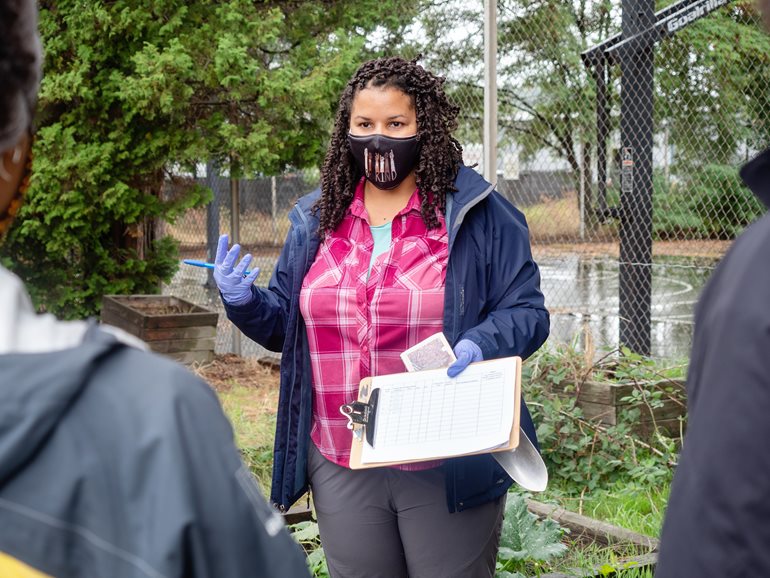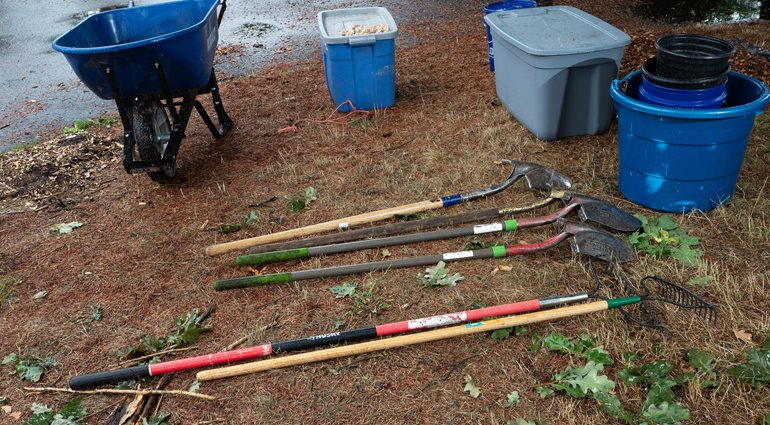
By Douglas Esser
What’s better than picking a fresh, red, ripe tomato and putting a few slices on a sandwich? It’s a taste of summer that can’t be beat — unless the tomato grew in contaminated soil. Obviously, it would be better to grow precious vegetables in soil that has been protected from or cleansed of permeating pollutants.
Melanie Malone, an assistant professor in UW Bothell’s School of Interdisciplinary Arts & Sciences, has been researching contaminants in urban gardens for years. Whether looking at soil in New York, Seattle or the Farm on the UW Bothell campus, she routinely detects petroleum, lead, arsenic and the chemical used in the popular weed killer, Roundup.
This summer, Malone and community partners received a Population Health Equity Research Grant to sample soil at gardens in Seattle’s South Park neighborhood. It’s close to the Duwamish River Superfund site, designated for a special federal cleanup program because of a century of industrial pollution. The neighborhood also is considered a “food desert,” an area that has limited access to affordable nutritious food.
Hidden in the soil

The work involves sampling soil at the South Park Community Center children’s garden and at Marra Farm, an a historic agricultural parcel under the city’s park system. In addition to her usual list of contaminants, Malone is looking for polychlorinated biphenyls (PCBs), which are known to be at the Superfund site and which may cause developmental problems in children.
Part of the work was a gathering on Sept. 25 at the South Park Community Center garden where Malone explained how to fill out a lab sample sheet, what soil colors mean and how to take a soil sample.
“Unfortunately for all the gardens I’ve sampled previously and the ones I’ve sampled this summer, I have found some concerning levels of contaminants in each garden,” Malone said.
“That’s another reason this project is so important,” she said. “We need to start thinking about remediation and ways to do it — especially ways that work for the community partners. The more they’re invested in it and the more they’re into the science of it, the better.”
Her current research project includes the contributions of three community partners.
Partners in the community

Black Farmers Collective: The collective is building a greenhouse at the South Park Community Center garden. Managing Director Raymond Williams said Malone and her team have helped them understand soil pollution, its potential health effects and ways to mitigate them. “She brings the science of soil remediation, and we bring the experience in construction and volunteer labor,” Williams said.
Malone advised that the greenhouse be equipped with high efficiency MERV 13 air filters to remove pollution that would otherwise settle in the soil.
Urban Fresh Food Collective: This collective is a collaboration of organizations trying to improve health equity in South Park. Director Gari Watkins notes that the neighborhood is home to immigrant, low income and youth populations.
“Removing contaminants from the garden and constructing a greenhouse around the existing beds to prevent future airborne contamination will provide another asset the community can leverage in times of need, such as these,” Watkins said, adding that it also serves as an outdoor teaching space for children at the community center.
“It’s really important that children see how their food grows and that they can interact with it,” Malone said.
Young Women Empowered: This mentorship organization supports Neli Jasuja, who runs an educational program at Marra Farm, and Lisa Kenny, a specialist in mycoremediation.
“Learning that the farm is actually not organic — containing traces of diesel, motor oil and heavy metals — was disappointing and unfortunately not surprising,” Jasuja said. “Given the environmental injustices the South Park neighborhood faces, we are dedicated to not only supporting community through growing local fresh produce but also healing the soil that makes this possible.”
Kenny is testing whether fungi can restore environmental damage. It takes four to six weeks to grow a mycelium network to target petroleum and chemicals known as PAHs that result from burning coal, oil and gasoline, she said.
“We hope to remediate concerning levels of contaminants present in soils throughout the South Park neighborhood,” said Kenny, who welcomed UW Bothell in leveraging resources to support a community that faces disproportionate environmental impacts.
Equity in community research

Partnering with communities of color that have been disproportionately impacted by the coronavirus pandemic was the purpose of the Population Health Equity Research grants. Malone’s team received about $20,000. It was one of 14 funded through the UW Population Health Initiative with a total of $378,000, including matching funds.
“Since this is a community-driven grant, it was the perfect opportunity, and all of us working on it are people of color, so it’s a great way to get science involved,” Malone said.
“This is the way I think research should be done. Community partners having interest in the science and also feeling comfortable with the University researcher is really important to me. I’m glad I’m working where I am,” said Malone, who has been at UW Bothell since autumn 2018 and is teaching Environmental Justice and Introduction to Geographic Information Systems.
“I’m glad the word is getting out,” she said, “so people are coming up with troubleshooting that we can engage in together and figure out how to resolve some of the issues that have come up.”“
Impact on food quality

Urban community gardens can have a real impact on nutrition by supplying fresh produce, which is hard for most food banks to provide because it can spoil quickly, Malone said.
“It’s really a huge thing to have access to fresh vegetables,” she said. “For them to have vegetables in their plot right there would be great. They can pull a tomato and put it on a sandwich. Or they can have a pumpkin and make pumpkin pie.”


